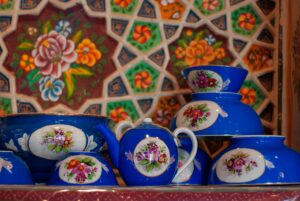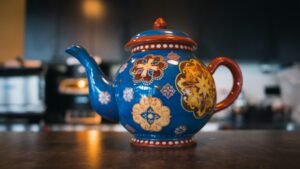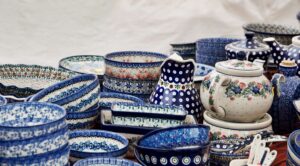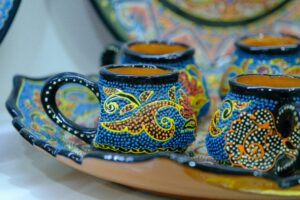Introduction: The Enchanting Legacy of Multani Blue Pottery
In the center of South Asia, where history and artistry are found, is the old city of Multan, Pakistan.
Multan is often called the cradle of civilization and a lighthouse of cultural heritage.
Many of the treasures have parts of vibrant multi-blue ceramics – a unique craft that has fascinated craftsmen and art lovers for centuries.
It is known for its striking cobalt blue and complex flower design, and is more than just decorative for ceramics.
It represents a deep artistic heritage located in the rich cultural past of the region.
This timely craft is a symbol of tradition, beauty, and identity through each piece of craft . Unlike traditional clay-based soil equipment, multani-blue pottery is designed with a special mixture of quartz and glass, making it a transit quality and a smooth finish that separates it. There is a delicate balance between science and art, which requires accuracy, patience, and a deep understanding of materials.
Table of Contents
In this article, we will discover the step-by-step process of making light blue ceramics through techniques passed down through generations. From source to raw materials to the last glaze, each stage is a testament to the craftsmanship of Potters of Multan. Whether you are an art enthusiast, a cultural historian, or just eager about traditional craftsmanship, this journey in the world of multani-blue pottery promises to be both informative and inspiring.
1. Understanding Multani Blue Pottery: Origins and Cultural Significance
It is important to understand the roots before multani-blue pottery is made in their technologies. This craft was brought to the Indian subcontinent by the Mughal craftsmen and was influenced by the origin of Central Asia and Persia. Over time, there was a permanent house in Multan, where local craftsmen processed and preserved technology. The style of this soil equipment is characterized by the use of a white background with dark blue pigments, and often reflects floral patterns, geometric shapes, and Islamic calligraphy. Unlike soil pots or stone vessels, multi-blue ceramics do not include a potter’s wheel. Instead, it depends on mold and hand-paint techniques, from which it is a specific form of ceramic art.
The cultural significance of Multani Blue Pottery is out of the question. It represents the compilation of Persian, Mughal, and indigenous traditions, which act as living objects in regional history. Today, efforts are being made to revive and maintain this craft, not only as an art but also as a source of livelihood for many craftsmen.
2. Gathering the Raw Materials: The Foundation of the Craft
The first step in making Multani Blue Pottery is to collect the required raw material. Unlike regular ceramics, which use soil, it is necessary for this craft:
Quartz powder, Glass powder, White clay (China Clay), Rubber Arabic or sodium carbonate, Mineral-based pigment (especially signal cobalt oxide for blue),
These materials are carefully measured and mixed to create a dough-like stability. Quartz and glass provide ceramics with transport and hardness, while white soil adds body. Rubber Arabic acts as a binding agent, which helps the mixture retain its shape during casting.
This unique composition ensures that soil equipment remains durable, capable of withstanding high temperatures without cracking.
3. Preparing the Dough: Crafting the Base Material
When the raw material is collected for Multani Blue Pottery, they are combined in a specific proportion to prepare the craftsman, “the flour” says. This is a careful process that includes:
To remove impurities to kill quartz and glass powder
Mix them with white soil and gum Arabic
Add slow water to achieve the correct texture
The resulting mixture must be sufficiently viable to squeeze the molds, but it should be enough to maintain the composition. This stage requires experience and competence, as stability directly affects the quality of the end product.
Potters are often dependent on testing and errors, and adjust the ratio based on moisture, temperature, and desired thickness of the elements.
4. Molding: Shaping the Beauty
Since multani-blue pottery is not made on a potter’s wheel, craftsmen use hand-cut wood or plaster to shape objects. These shapes come in different shapes, bowls, tiles, vases, and decorative pieces.
The prepared dough is strongly pressed into the mold to ensure the distribution and clarity of the design. When set, the piece is slowly removed and left to dry in the shade for several days. Drying too quickly can cause cracks, so this stage should be handled carefully.
Some designs include new patterns directly in the mold, which provides complex details without extra carvings.
5. Multani Blue Pottery Smoothing and Refining: Perfecting the Surface
After the early drought period, the Multani Blue Pottery passed through a steady process. Craftsmen use fine sand papers or polishing stones to eliminate rough edges and errors. This phase is important to achieve a smooth, shiny surface known for multi-blue ceramics.
The focus on expansion is crucial here. Even minor errors may be different from the elegance of the prepared piece. Some craftsmen may also hold further designs at this level, which can give the figure depth and complexity.
6. First Firing: Biscuit Firing
When the pieces become smooth and dry completely, they are subject to the first shooting, also known as biscuit firing. It occurs in an oven at temperatures from 800 ° C to 900 ° C.
The purpose of this shooting is to harden the ceramics and prepare them for windows. After shooting, the pieces become more porous so that the glass cover can effectively adhere.
This phase marks a significant twist in this process – soil equipment begins to enter its final shape, although it still lacks lively colors that define multi-blue ceramics.
7. Glazing: Infusing Color and Shine
Glass is probably the most visually transformative step in the construction of multi-blue ceramics. Using a soft brush, just fine painted glass, a liquid glass made of minerals and water on the surface.
Glass cover meets two goals:
Improve beauty appeal with a light finish
Seal
While the iconic cobalt blue is the most famous color, artists sometimes experiment with turquoise, green, and even gold accents. However, maintaining the authenticity of multi-blue ceramics means staying right to your traditional palette.
The wineup process requires a stable hand and a deep eye. Excessive glass cover can cause bubbling or dripping during final shooting, while it has very low unplanned surface tags.
8. Second Firing: Final Transformation
After glass, the pottery undergoes another shooting, known as the Glost shooting. It occurs at a slightly lower temperature than before, usually from approximately. 700 ° C to 800 ° C.
During this shooting, the glass melts and fuses with the body of the ceramic, resulting in a smooth, vitridified surface. The change is dramatic: Bar-mate pieces now shine with a light finish, and the dark blue color becomes sharp.
This phase requires careful monitoring, as uneven heating can lead to warping or cracks. Kushal -potatters are well aware of when to open the oven, depending on the experience, instead of the digital thermometer.
9. Multani Blue Pottery Hand-Painting: The Artistic Touch
Multani separates the blue ceramics, their complex hand-painted design. After the second shooting, craftsmen use fine brushes to paint the wide patterns on the shiny surface.
Traditional motifs include:
Flower billions, Geometric pattern, Calligraphy –Inscription, Medal,
Each stroke is deliberately performed, with layers of shading and outline of connection sales in the design. The pigment used is mineral-based, which ensures long life and vibrancy.
This phase is considered the craft soul – where the creativity of the artist glows the most bright rails. While some designs are repeated for generations, there are many basic compositions, reflecting the craftsman’s personality.
10. Final Firing: Sealing the Masterpiece
To lock and increase the durability of painted designs, there is a third and last step in ceramics. This low temperature shooting ensures that the color melts permanently with the glass coating, stops fading or tile.
At this point, the play is fully prepared and is ready to be valued, used, or sold. Each element is a unique work of art, which is the identity of centuries-old tradition and modern crafts.
11. Preservation and Revival: Keeping the Tradition Alive
Despite its beauty and historical significance, multani-blue pottery faces challenges in modern times. Industrialization, lack of effective labor, and transfer of consumer preferences threaten its existence.
In recent years, however, there has been a resuscitation of interest in traditional craftsmanship, which is influenced by global praise for handmade objects and durable practice. Organizations, Government Bodies, and Private Collectors Are Working Together to Support, Provide Training, and Promote Crafts Internationally.
Workshops and exhibitions in Multan and abroad help the new audience resume this art, ensuring that the Heritage from Multani Blue Pottery continues for future generations.
Conclusions: a symphony of skills and souls
Multani Blue Pottery is just more than decorative art – it is a story of flexibility, creativity, and cultural pride. From humble raw materials to wonderful works, each stage of the composition of a dedication of craftsmen who keep this tradition alive.
Whether appearing in a museum, holding a dining table, or embedded in architectural details, whispering and carrying multi-blue ceramics with the talent for human simplicity.
When we admire these timely works, let’s also remember our hands that shape them – Multan’s talented craftsman, whose artistry makes dust and fire permanent beauty.
Q1: What makes Multani Blue Pottery unique compared to other ceramics?
A: Unlike traditional clay pottery, Multani Blue Pottery uses a special mixture of quartz, glass powder, and white clay, giving it a translucent finish. It’s also hand-painted with intricate floral, geometric, and calligraphic designs, making each piece a unique work of art.
Q2: Is Multani Blue Pottery durable despite being delicate in appearance?
A: Yes, the unique composition and multiple firing processes make it strong and long-lasting. The glazing also adds a protective layer, enhancing its durability while maintaining its vibrant blue aesthetic.
Q3: Why is preserving Multani Blue Pottery important today?
A: It represents centuries of cultural heritage, blending Persian, Mughal, and local traditions. Supporting this craft helps sustain artisan livelihoods and keeps a historic art form alive in the modern world.





